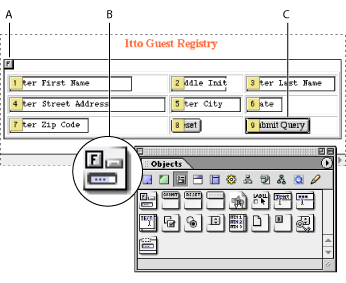 |
About designing forms
- Plan your form on paper. A clear understanding of the purpose, kind of information you need from your viewers, and how the form will look are very important. Mock up several layouts, test the logic of the flow, and the ease of use.
- Drag the Form icon onto a GoLive page. The form element tells the browser that the page is a form and specifies the location of the script that processes the viewer's data. The form element contains all the other elements of your design.
- Add a table to your page to provide the form's structural foundation. Tables help you arrange the form fields more easily and give you more predictable results across the different browsers and operating systems. You can control the table using the Table Inspector.
- Add form elements by dragging them into the table cells. The form elements become the fields your viewers will use to enter and post information. The Inspector lets you customize the fields and manage the collected data.
- Add a submit button so your viewers can submit their data to the server.
- Create a tabbing chain to help your viewers navigate within in the form using the tab key. You can specify the order in which the focus moves from one field to the next.
- Preview your form in a browser and test its functionality.
You design forms on an HTML page by dragging form elements from the Objects palette onto your page and setting element options in the Forms Inspector. Follow these steps to design a form:

Setting up a form A. Form icon contains all elements of a fill-in form B. Form icon C. Individual form elements placed in table cells